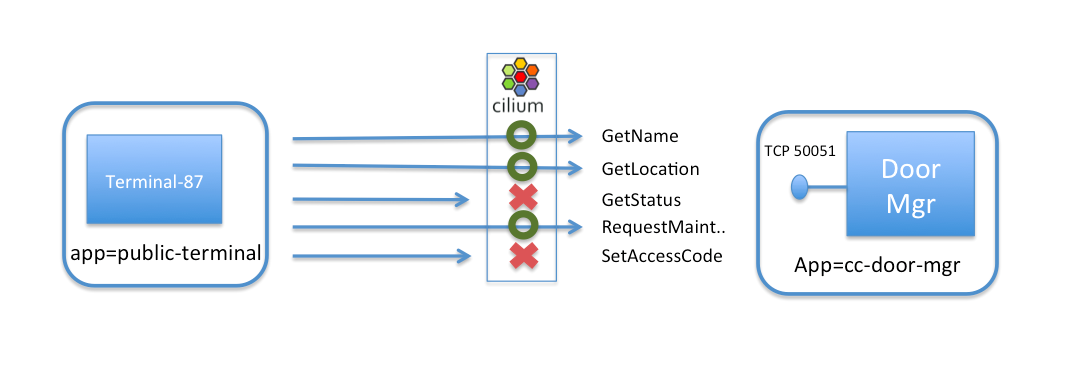Securing gRPC
This document serves as an introduction to using Cilium to enforce gRPC-aware security policies. It is a detailed walk-through of getting a single-node Cilium environment running on your machine. It is designed to take 15-30 minutes.
If you haven’t read the Introduction to Cilium & Hubble yet, we’d encourage you to do that first.
The best way to get help if you get stuck is to ask a question on Cilium Slack. With Cilium contributors across the globe, there is almost always someone available to help.
Setup Cilium
If you have not set up Cilium yet, follow the guide Cilium Quick Installation for instructions on how to quickly bootstrap a Kubernetes cluster and install Cilium. If in doubt, pick the minikube route, you will be good to go in less than 5 minutes.
It is important for this demo that kube-dns is working correctly. To know the
status of kube-dns you can run the following command:
$ kubectl get deployment kube-dns -n kube-system
NAME DESIRED CURRENT UP-TO-DATE AVAILABLE AGE
kube-dns 1 1 1 1 13h
Where at least one pod should be available.
Deploy the Demo Application
Now that we have Cilium deployed and kube-dns operating correctly we can
deploy our demo gRPC application. Since our first demo of Cilium + HTTP-aware security
policies was Star Wars-themed, we decided to do the same for gRPC. While the
HTTP-aware Cilium Star Wars demo
showed how the Galactic Empire used HTTP-aware security policies to protect the Death Star from the
Rebel Alliance, this gRPC demo shows how the lack of gRPC-aware security policies allowed Leia, Chewbacca, Lando, C-3PO, and R2-D2 to escape from Cloud City, which had been overtaken by
empire forces.
gRPC is a high-performance RPC framework built on top of the protobuf serialization/deserialization library popularized by Google. There are gRPC bindings for many programming languages, and the efficiency of the protobuf parsing as well as advantages from leveraging HTTP 2 as a transport make it a popular RPC framework for those building new microservices from scratch.
For those unfamiliar with the details of the movie, Leia and the other rebels are fleeing storm troopers and trying to reach the space port platform where the Millennium Falcon is parked, so they can fly out of Cloud City. However, the door to the platform is closed, and the access code has been changed. However, R2-D2 is able to access the Cloud City computer system via a public terminal, and disable this security, opening the door and letting the Rebels reach the Millennium Falcon just in time to escape.

In our example, Cloud City’s internal computer system is built as a set of gRPC-based microservices (who knew that gRPC was actually invented a long time ago, in a galaxy far, far away?).
With gRPC, each service is defined using a language independent protocol buffer definition. Here is the definition for the system used to manage doors within Cloud City:
package cloudcity;
// The door manager service definition.
service DoorManager {
// Get human readable name of door.
rpc GetName(DoorRequest) returns (DoorNameReply) {}
// Find the location of this door.
rpc GetLocation (DoorRequest) returns (DoorLocationReply) {}
// Find out whether door is open or closed
rpc GetStatus(DoorRequest) returns (DoorStatusReply) {}
// Request maintenance on the door
rpc RequestMaintenance(DoorMaintRequest) returns (DoorActionReply) {}
// Set Access Code to Open / Lock the door
rpc SetAccessCode(DoorAccessCodeRequest) returns (DoorActionReply) {}
}
To keep the setup small, we will just launch two pods to represent this setup:
cc-door-mgr: A single pod running the gRPC door manager service with label
app=cc-door-mgr.terminal-87: One of the public network access terminals scattered across Cloud City. R2-D2 plugs into terminal-87 as the rebels are desperately trying to escape. This terminal uses the gRPC client code to communicate with the door management services with label
app=public-terminal.

The file cc-door-app.yaml contains a Kubernetes Deployment for the door manager
service, a Kubernetes Pod representing terminal-87, and a Kubernetes Service for
the door manager services. To deploy this example app, run:
$ kubectl create -f https://raw.githubusercontent.com/cilium/cilium/1.15.4/examples/kubernetes-grpc/cc-door-app.yaml deployment "cc-door-mgr" created service "cc-door-server" created pod "terminal-87" created
Kubernetes will deploy the pods and service in the background. Running
kubectl get svc,pods will inform you about the progress of the operation.
Each pod will go through several states until it reaches Running at which
point the setup is ready.
$ kubectl get pods,svc
NAME READY STATUS RESTARTS AGE
po/cc-door-mgr-3590146619-cv4jn 1/1 Running 0 1m
po/terminal-87 1/1 Running 0 1m
NAME CLUSTER-IP EXTERNAL-IP PORT(S) AGE
svc/cc-door-server 10.0.0.72 <none> 50051/TCP 1m
svc/kubernetes 10.0.0.1 <none> 443/TCP 6m
Test Access Between gRPC Client and Server
First, let’s confirm that the public terminal can properly act as a client to the door service. We can test this by running a Python gRPC client for the door service that exists in the terminal-87 container.
We’ll invoke the ‘cc_door_client’ with the name of the gRPC method to call, and any parameters (in this case, the door-id):
$ kubectl exec terminal-87 -- python3 /cloudcity/cc_door_client.py GetName 1
Door name is: Spaceport Door #1
$ kubectl exec terminal-87 -- python3 /cloudcity/cc_door_client.py GetLocation 1
Door location is lat = 10.222200393676758 long = 68.87879943847656
Exposing this information to public terminals seems quite useful, as it helps travelers new
to Cloud City identify and locate different doors. But recall that the door service also
exposes several other methods, including SetAccessCode. If access to the door manager
service is protected only using traditional IP and port-based firewalling, the TCP port of
the service (50051 in this example) will be wide open to allow legitimate calls like
GetName and GetLocation, which also leave more sensitive calls like SetAccessCode exposed as
well. It is this mismatch between the course granularity of traditional firewalls and
the fine-grained nature of gRPC calls that R2-D2 exploited to override the security
and help the rebels escape.
To see this, run:
$ kubectl exec terminal-87 -- python3 /cloudcity/cc_door_client.py SetAccessCode 1 999
Successfully set AccessCode to 999
Securing Access to a gRPC Service with Cilium
Once the legitimate owners of Cloud City recover the city from the empire, how can they
use Cilium to plug this key security hole and block requests to SetAccessCode and GetStatus
while still allowing GetName, GetLocation, and RequestMaintenance?

Since gRPC build on top of HTTP, this can be achieved easily by understanding how a gRPC call is mapped to an HTTP URL, and then applying a Cilium HTTP-aware filter to allow public terminals to only invoke a subset of all the total gRPC methods available on the door service.
Each gRPC method is mapped to an HTTP POST call to a URL of the form
/cloudcity.DoorManager/<method-name>.
As a result, the following CiliumNetworkPolicy rule limits access of pods with label
app=public-terminal to only invoke GetName, GetLocation, and RequestMaintenance
on the door service, identified by label app=cc-door-mgr:
apiVersion: "cilium.io/v2"
kind: CiliumNetworkPolicy
metadata:
name: "rule1"
spec:
description: L7 policy to allow public terminals to call GetName, GetLocation, and RequestMaintenance, but not GetState, or SetAccessCode on the Door Manager Service
endpointSelector:
matchLabels:
app: cc-door-mgr
ingress:
- fromEndpoints:
- matchLabels:
app: public-terminal
toPorts:
- ports:
- port: "50051"
protocol: TCP
rules:
http:
- method: "POST"
path: "/cloudcity.DoorManager/GetName"
- method: "POST"
path: "/cloudcity.DoorManager/GetLocation"
- method: "POST"
path: "/cloudcity.DoorManager/RequestMaintenance"
A CiliumNetworkPolicy contains a list of rules that define allowed requests,
meaning that requests that do not match any rules (e.g., SetAccessCode) are denied as invalid.
The above rule applies to inbound (i.e., “ingress”) connections to cc-door-mgr pods (as
indicated by app: cc-door-mgr
in the “endpointSelector” section). The rule will apply to connections from pods with label
app: public-terminal as indicated by the “fromEndpoints” section.
The rule explicitly matches
gRPC connections destined to TCP 50051, and white-lists specifically the permitted URLs.
Apply this gRPC-aware network security policy using kubectl in the main window:
$ kubectl create -f https://raw.githubusercontent.com/cilium/cilium/1.15.4/examples/kubernetes-grpc/cc-door-ingress-security.yaml
After this security policy is in place, access to the innocuous calls like GetLocation
still works as intended:
$ kubectl exec terminal-87 -- python3 /cloudcity/cc_door_client.py GetLocation 1
Door location is lat = 10.222200393676758 long = 68.87879943847656
However, if we then again try to invoke SetAccessCode, it is denied:
$ kubectl exec terminal-87 -- python3 /cloudcity/cc_door_client.py SetAccessCode 1 999
Traceback (most recent call last):
File "/cloudcity/cc_door_client.py", line 71, in <module>
run()
File "/cloudcity/cc_door_client.py", line 53, in run
door_id=int(arg2), access_code=int(arg3)))
File "/usr/local/lib/python3.4/dist-packages/grpc/_channel.py", line 492, in __call__
return _end_unary_response_blocking(state, call, False, deadline)
File "/usr/local/lib/python3.4/dist-packages/grpc/_channel.py", line 440, in _end_unary_response_blocking
raise _Rendezvous(state, None, None, deadline)
grpc._channel._Rendezvous: <_Rendezvous of RPC that terminated with (StatusCode.CANCELLED, Received http2 header with status: 403)>
This is now blocked, thanks to the Cilium network policy. And notice that unlike a traditional firewall which would just drop packets in a way indistinguishable from a network failure, because Cilium operates at the API-layer, it can explicitly reply with an custom HTTP 403 Unauthorized error, indicating that the request was intentionally denied for security reasons.
Thank goodness that the empire IT staff hadn’t had time to deploy Cilium on Cloud City’s internal network prior to the escape attempt, or things might have turned out quite differently for Leia and the other Rebels!
Clean-Up
You have now installed Cilium, deployed a demo app, and tested L7 gRPC-aware network security policies. To clean-up, run:
$ kubectl delete -f https://raw.githubusercontent.com/cilium/cilium/1.15.4/examples/kubernetes-grpc/cc-door-app.yaml $ kubectl delete cnp rule1
After this, you can re-run the tutorial from Step 1.